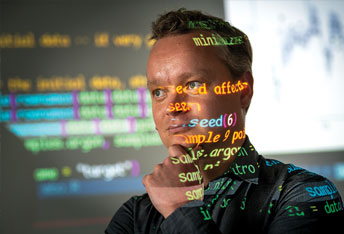
Contact Us
Institutional Communications
Bureau of Mines Building, Room 137
Laramie, WY 82071
Phone: (307) 766-2929
Email: cbaldwin@uwyo.edu
Into the Future
September 10, 2021

Lars Kotthoff in the Artificially Intelligent Manufacturing (AIM) Center.
Lars Kotthoff and the Artificially Intelligent Manufacturing Center use machine learning and artificial intelligence to advance science and manufacturing.
By Micaela Myers
As one of the leaders of the Artificially Intelligent Manufacturing (AIM) Center on campus, computer science Assistant Professor Lars Kotthoff collaborates with NASA, as well as students and faculty from a variety of disciplines, including computer science, various engineering fields, molecular biology, veterinary science and chemistry. His own research combines artificial intelligence (AI) and machine learning.
The AIM Center was initially funded by the College of Engineering and Applied Science Tier-1 Initiative. “The aim was to bring faculty from different disciplines together and apply machine learning and AI more generally to manufacturing materials,” Kotthoff says. “We want to get as many people involved as possible and spread the knowledge beyond the usual disciplinary boundaries.”
Advanced materials and manufacturing have made affordable mass production possible. However, designing new materials is a slow and costly process. AI and machine learning can replace time-consuming laboratory processes, as computational simulations reliably predict how to create the desired materials.
Last year, Kotthoff and two colleagues—Patrick Johnson in chemical engineering and Dilpuneet Aidhy in mechanical and energy systems engineering—were awarded a $750,000 NASA grant to work on developing machine learning materials and manufacturing methods for space. The three-year grant for their interdisciplinary project, titled “Artificially Intelligent Manufacturing of Flexible Electronics,” was funded through NASA’s Established Program to Stimulate Competitive Research (EPSCoR). Together with Ray Fertig in mechanical engineering, Kotthoff, Johnson and Dilponeet share leadership responsibilities at the AIM Center.
Simply put, AI and machine learning techniques help scientists identify patterns in data. With his personal research, Kotthoff looks at automated machine learning. For example, there are many machine learning methods, and the team is building models to determine how well different options will work in particular contexts.
Reaching beyond his college, Kotthoff consults with College of Agriculture and Natural Resources professors Brant Schumaker (veterinary science) and molecular biologists Todd Schoborg and Jay Gatlin, who were awarded grants from Microsoft’s AI for Earth program. They plan to use AI to perform image analyses in much the same way a human would—relying on the ability to “learn” what features are present in an image and then using that information to automatically identify those same features in subsequent images.
Students are a big part of the AIM Center. “We have students from many different disciplines,” Kotthoff says. “The idea is to build expertise, in particular for students in other engineering disciplines who might not be exposed to machine learning. They can use AI and machine learning in their respective fields.”
Contact Us
Institutional Communications
Bureau of Mines Building, Room 137
Laramie, WY 82071
Phone: (307) 766-2929
Email: cbaldwin@uwyo.edu


